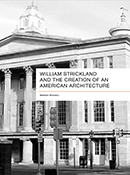William Strickland and the Creation of an American Architecture

“William Strickland and the Creation of an American Architecture is a significant contribution to the professional career of William Strickland and the history of architecture in the United States. Very little has been written about Strickland, one of the most important proponents of the Greek Revival style of architecture in the U.S. His work primarily in Philadelphia, but also elsewhere, was a major reason Greek Revival became known as the “National Style” in the first half of the nineteenth century.”—Norman R. Tyler, professor emeritus, Eastern Michigan University
“William Strickland and the Creation of an American Architecture is well researched and well written and filled with careful descriptions and insightful analyses of Strickland’s work.”—Michael W. Fazio, professor emeritus, Mississippi State University
William Strickland (1788–1854) was, in his day, among the most notable architects in the United States. An erstwhile student of Benjamin Henry Latrobe and a contemporary of Robert Mills, Strickland first entered the world of architecture at a young age in Philadelphia. But given that many of Strickland’s buildings have not survived, and considering the sparse and dispersed collection of primary sources Strickland left upon his death, little contemporary scholarship has appeared concerning Strickland’s significant contributions to the built environment of the early nineteenth century.
In William Strickland and the Creation of an American Architecture, Robert Russell does much to rectify this underrepresentation of Strickland’s notable architectural contributions in contemporary scholarship. In this first monograph detailing Strickland’s life and works since 1950 Russell examines the architectural production of Strickland during the first half of the nineteenth century.
Russell begins with the well-known Second Bank of the United States (Philadelphia)—the project that launched Strickland onto the national stage—eventually bringing his analysis to the south with an examination of the Tennessee State Capitol Building (Nashville). These two monuments bookended the American Greek Revival of the nineteenth century. Russell’s careful descriptions and insightful analyses of William Strickland’s work highlight the architect’s artistic skills and contributions to American material culture over the course of fifty years.
Ornamenting his examination with more than one hundred illustrations, Russell takes readers on a comprehensive journey through Strickland’s architecture. Part biography, part architectural history, William Strickland and the Creation of an American Architecture is an invaluable resource for scholars and artists alike, illustrating Strickland’s critical role in American architectural history and celebrating the icon behind buildings in Pennsylvania, Tennessee, and beyond that are still admired and appreciated today.
Robert Russell is a professor in the Program in Cultural and Historic Preservation at Salve Regina University in Newport, Rhode Island. He is the editor of Cornerstones of Justice: The County Courthouses of South Carolina and coauthor, with E. J. Johnson, of Memphis: An Architectural Guide.
